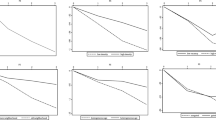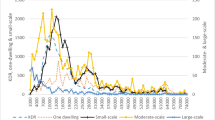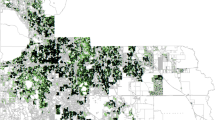Abstract
Historic property designations have been lauded for spurring renovation beyond the historic structures themselves through positive externalities in surrounding neighborhoods. Previous historic district research focuses on whether historic designation results in a price premium. This paper takes a more comprehensive look at the buying process, which must consider marketing duration within the historic district as well as influences on the sale of properties adjacent to the historic district. We examine how historic district designation in Baton Rogue, Louisiana is capitalized either through a price premium or marketing duration and how that mechanism differs between neighborhoods inside and outside the historic district boundaries. We employ a three stage least square, 3SLS, model to account for the effects of endogenous marketing duration on price capitalization estimates. The estimates are consistent with search-market theory in that marketing duration absorbs part of the capitalization of historic designation. We find that the more certain benefits from historic designation within the district are reflected in a price premium while the reduced regulation coupled with the cachet of being located near but not inside the district result in shorter marketing duration.
Similar content being viewed by others
Notes
Mason (2005) is a comprehensive survey of many strands of literature relating to the value of historic preservation, most of which point to positive net impacts of historic preservation.
None of the studies that use repeat sales methodology models space-time interactions or uses constant-liquidity model. Thus, the marketing duration question reminds unanswered.
See Sirmans et al. 2010 for a summary
This possible cross equation correlation calls for estimating the two separate equations as a seemingly unrelated system—the same method appropriate for estimating systems of consumer demand equations. See Turnbull and Zahirovic-Herbert (2012) for a price-time estimation using seemingly unrelated regression.
Haurin’s model offers an explanation for why houses with unusual attributes sell for less and take longer to sell (Haurin 1988, Jud, Seaks and Winkler 1996). To capture the property atypicality effects we use an alternative to this model that is presented in Turnbull, Dombrow and Sirmans (2006).
Given the combination of sparse transactions within historic districts and our rich dataset, we use a hedonic model approach to minimize the limiting assumptions necessary in the alternative approaches such as repeat sales or difference-in-difference. In addition, our careful spatial controls for neighborhood composition and market conditions help to control for characteristics that may be correlated with historic designation.
We have prepared a series of maps, but the number of overlapping census block groups, historic district boundaries, and the buffer zones around each of the district makes them difficult to read. However, they are available upon request.
References
Asabere, P. K., & Huffman, F. E. (1994). Historic designation and residential market values. The Appraisal Journal, 62(3), 396–401.
Belkin, J., Hempel, D. J., & McLeavey, D. W. (1976). An empirical study of time on market using multidimensional segmentation of housing markets. American Real Estate and Urban Economics Association Journal, 4(2), 57–75.
Brasington, D., & Haurin D. (2006). Educational outcomes and house values: a test of the value added approach. Journal of Regional Science, 46, 245–268.
Clark, D. E., & Herrin, W. E. (1997). Historical preservation and home sale prices: evidence from the Sacramento housing market. The Review of Regional Studies, 27, 29–48.
Coulson, E. N., & Lahr, M. L. (2005). Gracing the land of Elvis and Beale Street: historic designation and property values in Memphis. Real Estate Economics, 33(3), 487–507.
Coulson, N. E., & Leichenko, R. M. (2001). The internal and external impact of historical designation on property values. Journal of Real Estate Finance and Economics, 23(1), 113–124.
Davis, L. W. (2004). The effect of health risk on housing values: evidence from a cancer cluster. American Economic Review, 94(5), 1693–1704.
Ding, C., & Knapp, G. (2003). Property values in inner city neighborhoods: the effects of homeownership, housing investment, and economic development. Housing Policy Debate, 13(4), 701–728.
Ding, C., Simons, R., & Baku, E. (2000). The effect of residential investment on nearby property values: evidence from Cleveland, Ohio. Journal Real Estate Research, 19(1/2), 23–47.
Ford, D. (1989). The effect of historic district designation on single-family home prices. Journal of the American Real Estate and Urban Economics Association, 17, 353–362.
Haughey, P., & Basolo, V. (2000). The Effect of dual local and national register historic district designations on single-family housing prices in New Orleans. The Appraisal Journal, 68(3), 283–289.
Haurin, D. (1988). The duration of marketing time of residential housing. AREUEA Journal, 16(4), 396–410.
Heintzelman, M. D., & Altieri, J.A. (forthcoming). Historic preservation: Preserving value? Journal of Real Estate Finance and Economics.
Johnson, K. H., Benefield, J. D., & Wiley, J. A. (2009). Architectural review boards and their impact on property price and time-on-market. Journal of Housing Research, 18(1), 1–18.
Jud, G. D., Seaks, T. G., & Winkler, D. T. (1996). Time on the market: the impact of residential brokerage. Journal of Real Estate Research, 12, 447–458.
Krainer, J. (1999). Real estate liquidity. Federal Reserve Bank of San Francisco Economic Review, 0(3), 14–26.
Krainer, J., & LeRoy, S. F. (2002). Equilibrium valuation of illiquid assets. Economic Theory, 19(2), 223–242.
Leguizamon, S. (2010). The influence of reference group house size on house price. Real Estate Economics, 38(3), 507–527.
Leichenko, R. M., Coulson, N. E., & Listokin, D. (2001). Historic preservation and residential property values: an analysis of Texas cities. Urban Studies, 38(11), 1973–1987.
Listokin, D., Listokin, B., & Lahr, M. (1998). The contributions of historic preservation to housing and economic development. Housing Policy Debate, 9(3), 431–478.
Mason, R. (2005). Economics and historic preservation: A guide and review of the literature. Discussion paper, The Brookings Institution Metropolitan Policy Program
Miller, N. G. (1978). Time on the market and selling price. Real Estate Economics, 6(2), 164–174.
Narwold, A., Sandy, J., & Tu, C. (2008). Historic designation and residential property values. International Real Estate Review, 11(1), 83–95.
Noonan, D. S. (2007). Finding an impact of preservation policies: price effects of historic landmarks on attached homes in Chicago 1990–1999. Economic Development Quarterly, 21(1), 17–33.
Noonan, D. S., & Krupka, D. J. (2011). Making—or picking—winners: evidence of internal and external price effects in historic preservation policies. Real Estate Economics, 39(2), 379–407.
Romero, A. M. (2004). The positive externalities of historic district designation. The Park Place Economist, 12(1), 71–74.
Rosen, S. (1974). Hedonic prices and implicit markets: product differentiation in perfect competition. Journal of Political Economy, 82(1), 34–55.
Schaeffer, P. V., & Millerick, C. A. (1991). The impact of historic district designation on property values: an empirical study. Economic Development Quarterly, 5(4), 301–312.
Sirmans, C. F., Turnbull, G. K., & Benjamin, J. D. (1991). The markets for housing and real estate broker services. Journal of Housing Economics, 1(3), 207–217.
Sirmans, C. F., Turnbull, G. K., & Dombrow, J. (1997). Residential development, risk, and land prices. Journal of Regional Science, 37, 613–628.
Sirmans, G. S., MacDonald, L., & Macpherson, D. A. (2010). A meta-analysis of selling price and time-on-the-market. Journal of Housing Research, 19(2), 139–152.
Thompson, E., Rosenbaum, D., & Schmitz, B. (2011). Property values on the plains: the impact of historic preservation. The Annals of Regional Science, 47(2), 477–491.
Turnbull, G. K., & Dombrow, J. (2006). Spatial competition and shopping externalities: evidence from the housing market. Journal of Real Estate Finance and Economics, 2006(32), 391–408.
Turnbull, G. K., & Zahirovic-Herbert, V. (2012). The transitory and legacy effects of the rental externality on house price and liquidity. Journal of Real Estate Finance and Economics., 44(3), 275–297.
Turnbull, G. K., Dombrow, J., & Sirmans, C. F. (2006). Big house, little house: relative size and value. Real Estate Economics, 34(3), 439–456.
Zahirovic-Herbert, V., & Turnbull, G. K. (2008). School quality, house prices and liquidity. Journal of Real Estate Finance and Economics, 37, 113–130.
Zahirovic-Herbert, V., & Chatterjee, S. (2012). Historic preservation and residential property values: evidence from quantile regression. Urban Studies., 49(2), 369–382.
Author information
Authors and Affiliations
Corresponding author
Rights and permissions
About this article
Cite this article
Zahirovic-Herbert, V., Gibler, K.M. Historic District Influence on House Prices and Marketing Duration. J Real Estate Finan Econ 48, 112–131 (2014). https://doi.org/10.1007/s11146-012-9380-1
Published:
Issue Date:
DOI: https://doi.org/10.1007/s11146-012-9380-1




